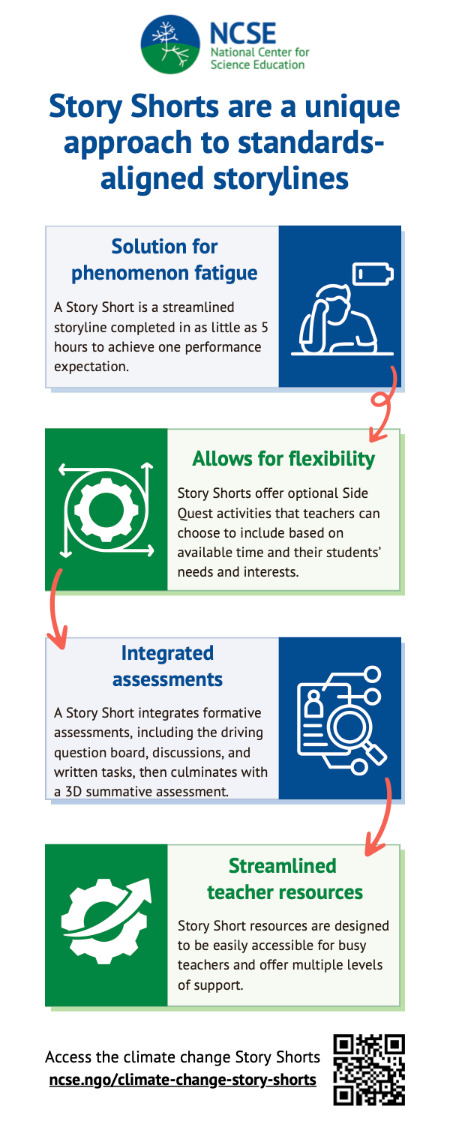Listening to science teachers, NCSE launches new Climate Change Story Shorts

The National Center for Science Education is excited to announce the launch of our new Climate Change Story Shorts: flexible mini-units that can be completed in as little as a week. The Story Short format is a unique approach to standards-aligned instructional storylines developed through our collaborative work with teachers. Each Story Short addresses one performance expectation while also directly confronting common misconceptions about climate change.
Storylines have emerged as the gold standard for science instruction because they engage students in the three dimensions of science to explain a phenomenon or solve a problem. However, facilitating students’ sensemaking about a complex phenomenon while simultaneously achieving multiple NGSS performance expectations often requires a long and complicated storyline. Three-dimensional teaching and learning also require shifts for both teachers and students, including more student talk and less teacher talk, a clearly established purpose for each activity connected to a driving question, increased collaboration among students, and more authentic assessments. Developing instructional resources that adequately support both students and teachers in making all of these shifts has proven to be a formidable challenge.
Since its inception, the Supporting Teachers team has worked closely with master teachers to develop instructional materials. We have purposely tackled topics, including evolution, climate change, and the nature of science, that are challenging to teach because they involve social controversies. As a result, students may come to the classroom with deeply held misconceptions that are difficult to resolve. Our approach has always been to tackle these misconceptions head-on in a non-confrontational way that we describe as BRAVE classroom practices. Starting in 2021, we conducted a two-year national curriculum field test (CFT) of our instructional units. Much of the CFT feedback echoes the challenges teachers across the country face as they take up standard-aligned storylines — they are overwhelmingly complex and difficult to orchestrate. Over the past year, we have used this feedback to entirely revise our climate change units into our new Story Short format. This format addresses four main issues:
 Issue #1 Phenomenon fatigue: A critical feature of storylines is that each learning activity is explicitly related back to a driving question about a specific phenomenon that drives the entire unit. Storylines are often complicated and take many weeks or months to complete, leading to a weariness among teachers and students that has been dubbed “phenomenon fatigue.” Storylines become long and complicated when they address multiple performance expectations. Integrating many performance expectations is a worthy goal because it allows for answering more complex questions, making important connections between topics, and accurately reflects the nature of science. However, students also crave novelty and can get frustrated when they feel like they have been learning about the same topic for too long. In addition, teachers often have difficulty keeping the “thread” of the unit going when there are so many different ideas to connect.
Issue #1 Phenomenon fatigue: A critical feature of storylines is that each learning activity is explicitly related back to a driving question about a specific phenomenon that drives the entire unit. Storylines are often complicated and take many weeks or months to complete, leading to a weariness among teachers and students that has been dubbed “phenomenon fatigue.” Storylines become long and complicated when they address multiple performance expectations. Integrating many performance expectations is a worthy goal because it allows for answering more complex questions, making important connections between topics, and accurately reflects the nature of science. However, students also crave novelty and can get frustrated when they feel like they have been learning about the same topic for too long. In addition, teachers often have difficulty keeping the “thread” of the unit going when there are so many different ideas to connect.
Our solution: Story Shorts are streamlined storylines that address just one performance expectation. We knew that we needed to find ways to simplify our storylines without watering them down. Rather than addressing multiple performance expectations, each Story Short aims to support students in meeting just one standard, which can be completed in as little as five hours of class time. In addition, our resources are targeted at helping students resolve specific common misconceptions about that topic. We carefully revised our materials based on the latest research and best practices in the field to ensure that each activity in the Story Short directly addressed a piece of the performance expectation as well as a common misconception.
Issue #2 Teaching to a script: When teachers try a new approach, they often feel like they are enacting a script written by someone else. This scripted feeling is especially associated with storylines because they are designed to lead students on a specific learning path that highlights many important connections along the way. At the same time, the goal of a storyline is to make sense from the students’ perspective, so the teacher has to merge the predetermined “script” with the students’ ideas and questions. As a result, implementing a storyline can often create tension for teachers as they attempt to weave together their own understanding of the content and the many responsibilities they carry in the classroom, the vision of teaching and learning promoted by the curriculum, and the ideas, interests, and questions put forth by their students.
Our Solution: Story Shorts are flexible storylines that clearly identify key activities necessary for achieving the performance expectation and resolving a specific misconception while offering optional activities that dig deeper or make other important connections. We call these optional activities Side Quests because they enhance the storyline, but their inclusion is based on the teacher’s discretion. The main activities of the Story Short are the essential building blocks for resolving the targeted misconception and achieving a particular standard-aligned learning goal. Side Quests offer additional opportunities for going deeper into a topic, filling in missing background information, meeting the needs of specific students, or for place-based adaptations. Side Quests are not merely optional extension activities to do if you have extra time, but rather ways that the storyline can be adapted to the needs of particular groups of students. Side Quests invite teachers to pay attention to their students’ interests, needs, and cultural ways of knowing and to veer off the “script” with intentionality. We believe the Side Quest feature helps teachers imagine how storylines can be adapted to their context and how they might construct and add their own Side Quests in the future.
Issue #3 Meaningful assessment: Assessment is an integral part of teaching and learning because it allows the teacher and students to better understand student thinking and how it compares to the target performance. The nuances of formative and summative assessment have been debated endlessly in the field, leaving teachers to grapple with concrete implementation issues, such as assigning grades and meeting accountability measures. New types of formative assessment have emerged as standardized assessments have transitioned to three-dimensional performance tasks. Meanwhile, teachers have been left questioning how to integrate all of these changes into the existing structures within their schools.
Our solution: Story Shorts seamlessly integrates formative and summative assessments. The first activity in each Story Short is specifically designed to uncover misconceptions students hold about a topic while supporting them in expressing their ideas and questions on a driving question board. Teacher support materials help teachers anticipate and respond to students’ ideas and questions and connect each learning activity back to students’ ideas and questions. Learning activities also invite students to directly respond to common misconceptions using the latest scientific evidence. Finally, each Story Short concludes with a summative assessment task that requires students to apply the knowledge and skills they learned to explain a slightly different phenomenon.
Issue #4 Mismatch between resources and the needs of teachers: Just like students, teachers have different strengths, weaknesses, and preferences. While NGSS-aligned resources often highlight how to meet differing students’ needs, they rarely take teachers’ differing needs into account. When resources consider teachers' needs, it usually means adding more information, resulting in longer and more complicated instructions. To be fair, this is a tricky balance for curriculum developers! Some teachers need additional support with the science content, some need support with pedagogical strategies, and others need logistical support in managing students and materials. To further complicate things, teachers’ needs shift based on the context of the lesson and at different points in the school year. Thus, it is understandable that teacher support resources often become long and complicated.
Solution: Enhanced teacher support targeted to different needs. While we can’t solve every problem for teachers, we listened carefully when they told us that the teacher resources for most publicly available NGSS storylines are too long and complicated. As former teachers, the NCSE Supporting Teachers team understands how busy teachers are and that they don’t have time to dig through long documents to find what they need. Many features of our new Story Shorts were explicitly designed to address these challenges. We developed an overview document for each Story Short that allows teachers to see the big picture and access the materials quickly. From the overview, teachers click on a link for each activity and find teacher instructions with links to all the resources they need, including student handouts, slide decks, and supplementary resources such as cards and data sets. The teacher instructions are organized to allow teachers to easily access what they need. The instructions for each activity begin with a series of simple graphic organizers that help teachers swiftly understand how the activity fits within the larger Story Short and access materials. These graphic organizers are often all a veteran teacher would need to facilitate the activity. However, we also include step-by-step directions below the graphic organizers that support teachers in implementing each part of the lesson should they need it.
Flexible approach
The flexible approach to three-dimensional instruction embedded within NCSE’s Story Short format best serves the needs of both teachers and students. Throughout the revision process, NCSE’s teacher ambassadors and field testers implemented new activities and provided feedback on the materials. We have shared the process of developing Story Shorts at multiple regional, state, and national conferences and received very positive feedback from teachers and teacher educators alike. The Supporting Teacher’s team is thrilled to finally be able to share our five Climate Change Story Shorts with the public. We invite you to try them out this school year and share your experiences with us either in the NCSE Supporting Teachers Facebook group or via email at touchet@ncse.ngo.
PS: And, in case you’re wondering, our next team project will follow the same process to update our current evolution and nature of science storylines. So, stay tuned!






